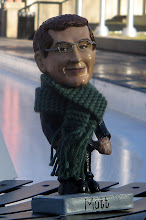What is the meaning of life? That was all—a simple question; one that tended to close in on one with years. The great revelation had never come. The great revelation perhaps never did come. Instead there were little daily miracles, illuminations, matches struck unexpectedly in the dark; here was one. This, that, and the other; herself and Charles Tansley and the breaking wave; Mrs. Ramsay bringing them together saying, “Life stand still here”; Mrs. Ramsay making of the moment something permanent (as in another sphere Lily herself tried to make of the moment something permanent)—this was of the nature of a revelation. In the midst of chaos there was shape; this eternal passing and flowing (she looked at the clouds going and the leaves shaking) was struck into stability. Life stand still here, Mrs. Ramsay said. “Mrs. Ramsay! Mrs. Ramsay!” she repeated. She owed it all to her.At one point during Michael Tilson Thomas' audition masterclasses he began talking about manipulating the quality of time's passing. Thinking about suspended time sent me searching for this passage in To the Lighthouse, a novel which to me is all about beautifully captured moments. As musicians, we also have a magical ability to make "life stand still here," to give shape and stability in the midst of chaos.
-To the Lighthouse by Virginia Woolf, p. 161
One violinist played a Mozart concerto, and while her performance was hardly chaotic, it may have been a bit tense. MTT talked about the experience of 'now,' and how it differs between the performer and the audience. The performer's experience might be a merciless procession of anxiety-inducing events - "now change the stroke, now make the shift, now emote!" Whereas the audience member's sense of now is more "wobbly" - therefore more yielding and relaxed. So we can engage with that audience member more successfully if we can find our way to a more breathing, "springier" sense of time. This can give us more space to execute all those merciless events , and perhaps ease some of the anxiety. Probably every performer has been told countless times to "relax!" - but I thought MTT managed to convey this advice in an unusually helpful way.
Of course, each musical idea has its own quality of pulse, and not everything should sound like a sunny, relaxed Mozart violin concerto. MTT expressed this by saying that every pulse has a 'what' and a 'how' as well as a 'where.' We create the what and how with articulation, resonance, energy, direction - all the nuances that can make two works in the same tempo sound infinitely different.
During one New World Symphony rehearsal, MTT was describing Toscanini's rehearsals with the NBC Symphony, and how Toscanini would cajole and plead with the orchestra, "legato, espressivo, con amore..." Then they would play it, full of all that juicy expression, and he would scream "MA IN TEMPO!" For Maestro Toscanini, apparently, those wobbly 'now's were a little too wobbly. Our challenge is to fit nuance, style, shape and life into the eternal passing and flowing of time. It may not be the great revelation to that simple question from To the Lighthouse, but it's a pretty interesting problem to work on nevertheless.
For more on MTT's musical ideas, read this post about Strauss' Don Juan.


 Technorati Link Count: no. of blog reactions to this post
Technorati Link Count: no. of blog reactions to this post
No comments:
Post a Comment